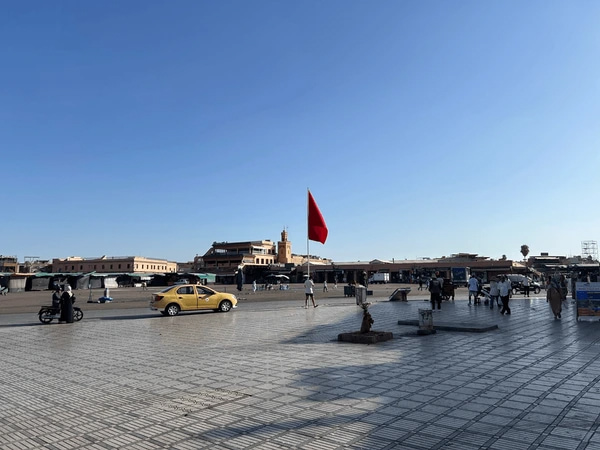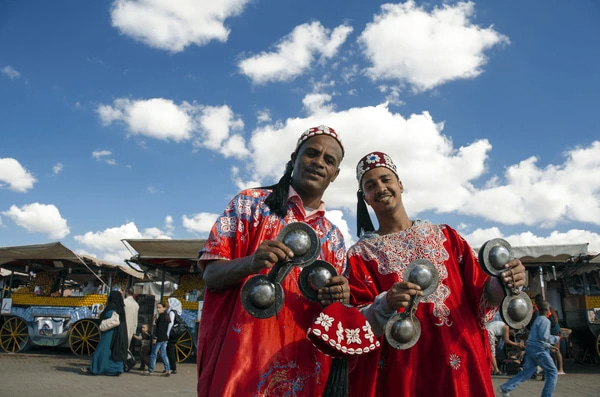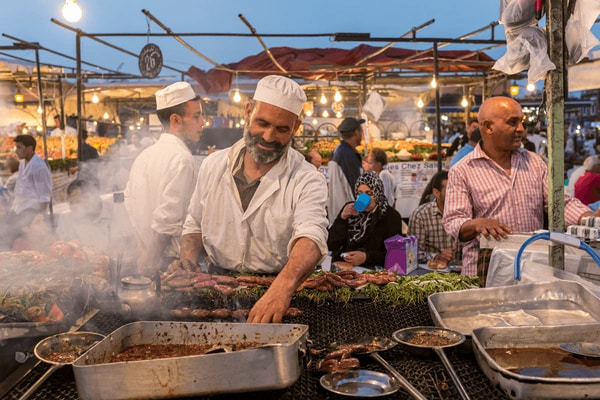Jemaa el Fna Square is the lively heart of Marrakech, Morocco. Located in the old city, also known as the Medina Quarter, this open space is filled with colors, sounds, and flavors that create a truly unique experience. As a public square, Jemaa el Fna has been a gathering place for centuries, where locals and travelers enjoy food, entertainment, and tradition.
Walking through the square, you’ll see fascinating sights, like snake charmers, henna artists, and storytellers practicing the ancient art of halqa, or storytelling circles. These performances keep Moroccan culture alive, passing down tales and traditions that are part of the city’s heritage. The square is also famous for its food stalls, offering treats like fried fish, tagine, and freshly squeezed orange juice. It’s a place where every sense comes alive, from the smell of spices to the lively music echoing through the square.
Jemaa el Fna is more than just a market; it’s a cultural space recognized by UNESCO as an “Intangible Heritage of Humanity.” This special recognition means that the square’s unique traditions and oral history are preserved, protecting the rich heritage of the Moroccan people. As the sun sets, Jemaa el Fna transforms into a vibrant night market, with even more attractions and entertainers filling the square.
Table of Contents
When to Visit Jemaa El-FnaSquare

Jemaa el Fna Square offers a vibrant experience year-round, but some seasons make visiting more comfortable and enjoyable. Spring (March to May) and fall (September to November) are considered the best times to see because of the mild temperatures, making it ideal for walking around the medina and exploring the sights without intense heat. These seasons also create colorful blooms in the surrounding landscapes, creating a picturesque setting around Marrakech.
During summer, temperatures in Marrakech can reach over 100°F (38°C), making midday exploration challenging, although early mornings and evenings are manageable. Winter is cooler, with average temperatures around 50°F to 70°F (10°C to 21°C), and though nights can be chilly, the square’s lively atmosphere remains unchanged.
Time of Day:
- Morning: Jemaa el Fna is quieter in the early morning, with fewer crowds and a peaceful atmosphere. Vendors set up their stalls, and performers prepare for the day. This is a perfect time to explore the market stalls, browse for unique souvenirs, or visit nearby historical sites like the Koutoubia Mosque and the Ben Youssef Mosque.
- Midday: By midday, the square begins to fill with tourists and locals alike. The sounds of performers, the calls of vendors, and the aromas from food stalls create a sensory experience. This is the best time for daytime activities, like watching snake charmers, henna artists, and monkey handlers interact with the crowds.
- Evening and Night: As the sun sets, Jemaa el Fna transforms into a bustling night market. Food stalls light up, creating an irresistible aroma of Moroccan spices and grilled meats. Evening entertainment ramps up, with storytellers, musicians, and dancers drawing in crowds with lively performances. Nighttime is the best time to experience the square’s magical energy and culinary delights.
A Journey Through History
Jemaa el Fna Square has a storied past that goes back to the 11th century when it was established under the Almoravid dynasty, which founded Marrakech. Initially, the square served as a vital hub for trade, gathering merchants from across North Africa and beyond. It was a place of exchange for goods and ideas, setting the foundation for the square’s role as a cultural crossroads.
The Almohads, who later took control, expanded the square and constructed the Koutoubia Mosque, a towering symbol of Marrakech. Over centuries, Jemaa el Fna became more than just a market—it transformed into a gathering place for celebrations, entertainment, and even judicial events, such as public executions. This history has shaped Jemaa el Fna into a place where life’s highs and lows have been witnessed for generations.
In 2001, UNESCO declared Jemaa el Fna a “Masterpiece of the Oral and Intangible Heritage of Humanity,” recognizing the square’s unique cultural traditions. This status highlights not just the historical importance of the space but also the value of preserving the cultural expressions that unfold within it every day. By honoring oral traditions and public performances, UNESCO has helped to safeguard Jemaa el Fna’s role as a living testament to Moroccan heritage.
Cultural Significance and Unique Traditions

Jemaa el Fna represents the heart of Moroccan culture, bringing together Berber, Arab, and African influences in one dynamic space. This is a cultural space where traditional arts, music, and oral storytelling (halqa) thrive, keeping ancient customs alive in the face of modern change. In Jemaa el Fna, culture is not confined to museums—it’s lived, performed, and shared.
Unique Traditions:
- Street Performances: Jemaa el Fna is famous for its snake charmers, who use flutes to “charm” the snakes, mesmerizing visitors. Musicians play Gnawa music, an ancient style from sub-Saharan Africa featuring drums and string instruments.
- Storytelling (Halqa): Storytelling circles are a tradition that has been part of the square for generations. In these circles, called halqa, storytellers narrate folktales, legends, and moral stories, often drawing large audiences.
- Henna Art: Henna artists are commonly found around Jemaa el Fna, creating beautiful, intricate designs on hands and feet. Henna has cultural significance in Morocco, often used in celebrations and festivals.
- Fortune Telling: Some visitors seek fortune tellers in the square, who offer predictions and insights into future events, using palm readings and other traditional practices.
Jemaa el Fna’s cultural role goes beyond entertainment. It’s a space where generations pass down skills, stories, and art forms, creating a living museum of Morocco’s intangible cultural heritage.
Exploring Jemaa El-Fna During the Day
During the day, Jemaa el Fna is bustling with activity. Visitors can explore countless market stalls filled with handmade goods, colorful fabrics, and aromatic spices. From brass cups to intricate jewelry, the square’s vendors showcase Moroccan craftsmanship at its finest.
Beyond shopping, the square is alive with performances. Snake charmers, monkey handlers, musicians, and dancers are set up in different parts of the square, creating a lively atmosphere. Watching these performers is like stepping into a world where tradition and art blend seamlessly.
The Medina quarter around Jemaa el Fna is also rich in history. Landmarks like the Koutoubia Mosque, the largest mosque in Marrakech, and the historic Ben Youssef Madrasa are within walking distance, offering visitors a glimpse into the city’s architectural beauty. There are also several cafes around the square, where you can relax and enjoy Moroccan mint tea or fresh orange juice.
Exploring Jemaa el Fna during the day allows you to experience the vibrant colors, sounds, and scents of Marrakech up close.
Jemaa El-Fna at Night – An Unforgettable Experience
When night falls, Jemaa el Fna truly comes alive. The square transforms into an open-air food market, with dozens of stalls setting up to serve traditional Moroccan dishes. The scents of grilled meats, spices, and sweets fill the air, inviting everyone to sample the local cuisine.
Night Market Highlights:
- Food Stalls: Jemaa el Fna’s food stalls offer a variety of Moroccan dishes, including tagine, a slow-cooked stew of meat and vegetables; fried fish; and skewered kebabs. You can also try harira, a traditional Moroccan soup, or end your meal with local sweets like pastries and honey-coated treats.
- Live Entertainment: Musicians, dancers, and acrobats perform throughout the square. The sound of drums, flutes, and other instruments creates a festive mood, while performers like fortune tellers and storytellers entertain the crowds with stories and traditional tales.
- Henna and Art: Henna tattoo artists continue working into the evening, offering temporary designs inspired by Moroccan art. You’ll also find artists creating intricate sand paintings and calligraphy.
Navigating Jemaa el Fna at night requires a sense of adventure. The square is packed with visitors, and each turn brings something new to discover. From the sights of street performers to the taste of Moroccan cuisine, every moment at Jemaa el Fna after sunset is filled with unforgettable experiences.
Where to Eat at Jemaa El-Fna

Food is a big part of the Jemaa el Fna experience, and the square offers options for every craving. The food stalls at night are an attraction themselves, each offering freshly prepared Moroccan dishes. You can sample tagine, a stew that’s slow-cooked in clay pots, or try brochettes (grilled meat skewers) seasoned with Moroccan spices.
For a unique dining experience, visit rooftop cafes like Café Glacier or Café de France, which offer panoramic views of the square. From these spots, you can watch the lively atmosphere below while sipping mint tea and enjoying a quiet meal.
Popular dishes include fried fish, Moroccan-style snails, and orange juice freshly squeezed on the spot. Jemaa el Fna’s street food scene gives visitors a taste of traditional Moroccan flavors that you won’t find anywhere else.
Where to Stay Nearby
Choosing a place to stay near Jemaa el Fna allows you to experience Marrakech’s medina from morning until night. Many visitors stay in riads, which are traditional Moroccan houses with interior courtyards that have been turned into guesthouses. Popular options include Riad Yasmine and Riad BE Marrakech, both of which offer an authentic Moroccan stay with beautiful decor and a warm atmosphere.
For those seeking a more luxurious experience, hotels like La Mamounia and Les Jardins De La Koutoubia provide high-end amenities and easy access to the square. Staying close to Jemaa el Fna means you’re just steps away from the action, making it easy to explore the square at any time.
Consider factors like budget, location, and the experience you want when choosing where to stay near Jemaa el Fna. Riads offer charm and authenticity, while hotels provide added comfort and services.
Essential Tips for Visitors
Exploring Jemaa el Fna can be overwhelming, especially for first-time visitors. Here are some essential tips to make your visit enjoyable:
- Stay Alert: The square is crowded, so keep your belongings close and be aware of your surroundings. It’s easy to get caught up in the excitement, but safety should always come first.
- Bargain Respectfully: In Moroccan markets, bargaining is part of the culture. Be polite and enjoy the process, but don’t feel pressured to buy if you’re not interested. Vendors often expect negotiation and may start with a high price.
- Dress Respectfully: Modest dress is appreciated, especially in religious sites or when interacting with locals. While the square is a tourist area, it’s also a local gathering place, so dressing respectfully is a way to show cultural awareness.
- Ask Permission for Photos: Many performers, like snake charmers or henna artists, prefer a small payment for photos. Always ask first, as this shows respect for their work.
Following these tips will help you have a smoother and more enjoyable experience in Jemaa el Fna.
Conclusion
Jemaa el Fna Square is a cultural treasure at the heart of Marrakech. With its rich history dating back to the 11th century, this bustling square has grown from a simple marketplace to a vibrant gathering place where Moroccan traditions come alive. From the UNESCO designation that honors its unique intangible heritage to the performances that echo ancient customs, Jemaa el Fna is much more than a tourist attraction; it’s a living museum of Moroccan life and history.
Whether you’re visiting Jemaa el Fna in the early morning to explore the markets or at night to enjoy the dazzling array of food and entertainment, every moment spent here is a discovery. The mix of sights, sounds, and tastes makes the square an unforgettable experience that immerses you in the essence of Moroccan culture. Watching snake charmers, listening to traditional music, or tasting dishes like tagine and mint tea creates memories that will stay with you long after you leave.
Exploring Jemaa el Fna is a journey that captures the vibrant spirit of Marrakech. From the market stalls to the storytelling circles, the square brings together locals and travelers in a celebration of Morocco’s unique heritage. Whether you’re looking to shop, dine, or simply soak up the lively atmosphere, Jemaa el Fna offers something for everyone, making it an essential part of any visit to Marrakech.
FAQs
What are the opening hours of Jemaa el Fna Square?
Jemaa el Fna is open 24 hours a day, with different activities at different times, but it’s busiest in the evening.
Is there an entrance fee to visit Jemaa el Fna?
No, Jemaa el Fna Square is free to enter. However, certain performances or activities may ask for a small tip.
How can I get to Jemaa el Fna from the airport?
You can reach Jemaa el Fna by taxi, which takes about 20 minutes from Marrakech Menara Airport.
Are guided tours available for Jemaa el Fna?
Yes, many companies offer guided tours of Jemaa el Fna and the surrounding medina.
